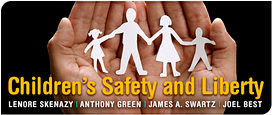I confess that I am old enough to remember coming home with a bag full of candy on Halloween, and how my mother would examine all of the unpackaged goodies for razor blades and items that could have been poisoned. Thankfully, M&Ms in their bags were okay. Whether there were covens of evildoers trying to commit murder by Halloween treats, I don’t know.
I do know, however, that parents can do a little safety homework to make sure Halloween is the fun night that we all want it to be. The vigilance is important because, according to a study by State Farm Insurance, a kid is on average twice as likely to be hit and killed by a car on Halloween than any other day (or night) of the year.[1] More broadly, we at Safe Kids Worldwide conducted a study on pedestrian safety, supported by FedEx, showing that each day, an estimated 61 children in the United States aged 19 and under are injured as pedestrians—more than 425,780 children in the last 15 years. It also showed that there has been a shift in injuries from younger kids to older ones.[2]
This is why we at Safe Kids Worldwide provide parents and caregivers with tips on pedestrian safety for everyday walking and getting around on Halloween night. It’s all common sense, like walking on sidewalks and paths and crossing at corners: Research shows that 70% of the Halloween crashes occur when children cross in the middle of the block.[3]
The key here is that real child safety efforts are based on research and facts and data, and not myths and exaggerated news stories, as Mr. Best suggests.
I salute Mr. Best, because his article was reasoned, without a reliance on sarcasm and fictions. However, I disagree with his analysis that child injuries and deaths, and remedies for them, are trickle-down crises, in which the risks get smaller and smaller. He suggests that as “bigger problems get solved, smaller ones come to the fore.” He cites seat belts and child-proof bottle caps for medications.
It’s not right to say that auto crashes (resolved by seat belts and booster seats) is a smaller problem. Car crashes have been and remain the number one cause of unintentional death in kids 19 and under, though it is true that there has been good progress over the past ten years.[4] In 2010 there were 4,077 motor vehicle-related fatalities among children ages 19 and under.[5] A smaller problem? I don’t think so.
That gets us to the question Mr. Swartz wisely asks, “How many children need to be sacrificed to make a product safer or remove a product from the market?”
Safety minded parents are on duty every day—and those of us engaged in child safety are here to help them. Not with helicopters, but with common sense based on real research. We are part of the community of care because that means that a happy Halloween leads to a happy Thanksgiving and the next set of holidays. As I said, I remember the days of razors in Halloween apples, and Halloween remains my favorite holiday.
Notes
[1]”Halloween is ‘Deadliest Day’ Of The Year For Child Pedestrian Fatalities,” State Farm, press release, October 23, 2012, http://www.multivu.com/mnr/56790-state-farm-halloween-pedestrian-child-safety.
[2] Mickalide AD, Rosenthal KM, Green A, Baker JM. “Walking Safely: A Report to the Nation.” Washington, DC: Safe Kids Worldwide, August 2012, http://www.safekids.org/assets/docs/safety-basics/safety-tips-by-risk-area/Walking-Safely-Research-Report.pdf.
[3] Op cit. Halloween is ‘Deadliest …”
[4] “National Action Plan for Child Injury Prevention,” Centers for Disease Control and Prevention, April 12, 2012, http://www.cdc.gov/safechild/NAP/toc.html.
[5] National Highway Traffic Safety Administration Fatality Analysis Reporting System (FARS) Encyclopedia. http://www.nhtsa.gov/FARS.

